
FIRST QUARTER, MARCH 2014 VOLUME 28, NUMBER 3
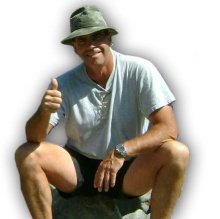
Newsletter By Dave McCracken General Manager
Story, video and images by Alan Mash & John Rose
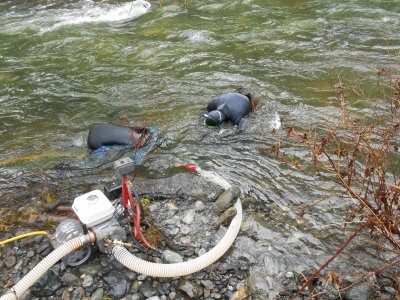
Early March is a heck of a time to do underwater mining. The water is cold, and on this particular day, the creek was running higher and faster than normal because of a rain storm just a few days before.
I wanted to experiment with this new method of underwater blow mining in California before the warmer weather gets started. So I decided to visit Happy Camp to try it out on the New 49er South Fork of Indian Creek property. This is a place which is well known for producing nice gold nuggets. I once recovered quite a large gold nugget using a metal detector along the bank of the stream on this property. Bedrock is very close to the surface in most places. So you don’t have to work that hard to get down to the cracks where gold can be found. I was doing quite well there using a suction dredge several years ago.
Before going down, I lined up Steve Jones and John Rose to come on out and join me for an adventure. Those guys are always ready to go! Several other New 49’er members also came along. Since I have the most experience doing underwater video, Steve jumped right in there with the nozzle and did a lot of the mining work. This is Steve’s second winter supporting himself from the gold that he mines along the Klamath River. He’s a hardy guy!
Using the blow mining method is the same thing as using a blaster nozzle on a suction dredge to cut through and break up hard-packed layers and bedrock that a dredge nozzle won’t take apart. But in this case, we were mainly using the blow nozzle to help move material out of the way and help us get down to the bedrock cracks faster. Really, this is just a step further than raking and fanning material out of the way with your hands.
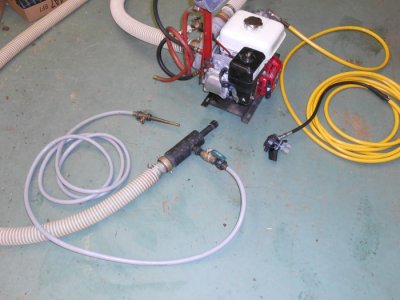
Steve and John suggested we could take the process one step further and blow the material into a second blowing device with a hopper that can be used to direct material through a hose to a sluice box (see next section below). But since South Fork mostly has bigger gold, we decided to just use the primary blower nozzle to see what we might find by uncovering some cracks on the edge of the creek.
We were using a 6.5 HP motor, mostly running on idle, with a standard mining pump and hookah compressor to supply underwater breathing air. You could also use a normal trash pump for underwater blow mining in shallow water. It’s pretty easy to adapt some ABS or PVC fittings to a pressure hose coming off the pump. Any motor that otherwise might be used to power a dredge or high-banker can be easily adapted to this kind of mining. My own dredge uses a Keene 1-inch high pressure hose going to a blaster nozzle tip. That provides plenty of power to push material around underwater!
John captured this video afterwards, while we explained what we were doing:
The gravel and overburden on the edge of the creek was only about a foot thick when we started. Sometimes it takes more effort to strap on divers weights when working in shallow water. We decided to tough it out without them. John explained what we were doing in the following video sequences:
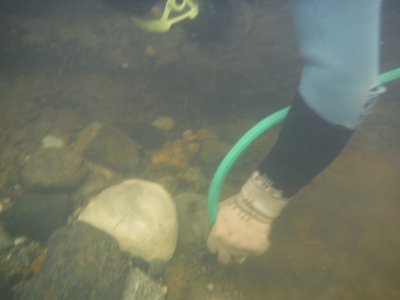
A larger 1 ½-inch blaster hose and nozzle was connected to the pump which certainly would have moved the overburden off faster. But since that would have made the underwater filming more difficult to capture, and there was only about a foot of material to move out of the way, we decided to just use a garden hose without the blaster nozzle tip at first to help move most of the top material off. Once we got down to bedrock, we attached the narrower-tipped blaster nozzle to help take apart decomposed bedrock. We were hoping to find some gold underneath. Here is some of the underwater action:
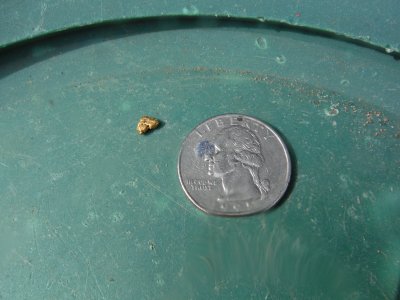
We were all pleasantly surprised to discover that it is quite easy using this method of underwater blowing to gain access to shallow gold deposits. By this, I mean shallow material. You can use this method in deeper water with the use of hookah gear. I’m looking forward to using this method along the banks of the extensive new mining properties The New 49’ers have acquired downstream of Happy Camp during the past few months. I’m sure those areas have not been mined during the modern age!
Shortly after reaching bedrock, we found a beautiful Indian Creek nugget stuck in a crack in the bedrock. I’m pretty sure I saw the nugget first because I was upstream with the camera from the slight cloud Steve was stirring up with the nozzle. For just a moment, I thought Steve was going to blow the nugget away! But, of course, gold is too heavy for that. Fortunately, I had the video camera on at the moment of discovery:
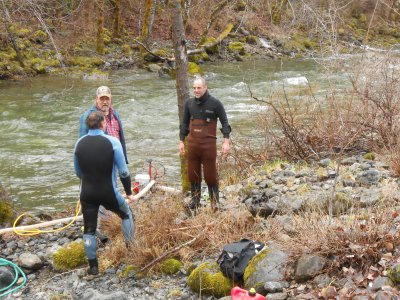
We wanted to do more prospecting; but after getting out of the water to congratulate ourselves, we found ourselves shivering up on the bank. We had such a great time exploring this new method of mining, we finally decided to call it a day and start making plans for the next time.
There seem to be more New 49’er members around Happy Camp this year than during prior winters that I have spent down there. It’s always a great time visiting with other members! Maybe next time I will use a wet-suit heater so I can devote more time recovering those easy nuggets. Or better yet, spring is only about a month away!
Taking Blow Mining to the Next Level!
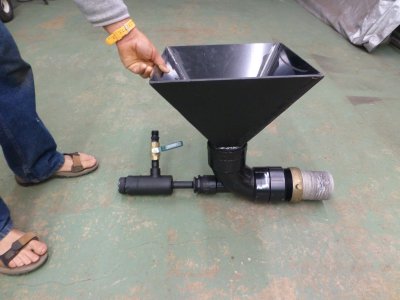
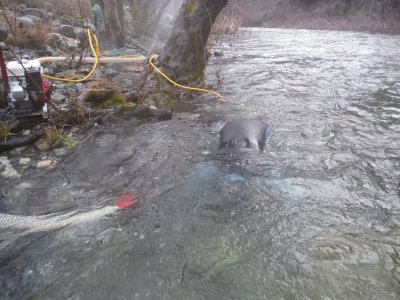
Last season, when the State of California decided to redefine “suction dredging” as “…the use of a suction system to vacuum material from a river, stream or lake for the extraction of minerals,” we immediately went to work on creating a new system which relies completely on water blowing to move streambed material to a hopper either above or below the water, and then through a hose to either a container or recovery system.
While the new system relies upon the same types of engines, pumps and underwater breathing systems we have historically used in most of our small scale mining activities, there is no suction or vacuum employed to excavate material off the bottom of the waterway. We only use blowing, thus the new term “blow mining.”
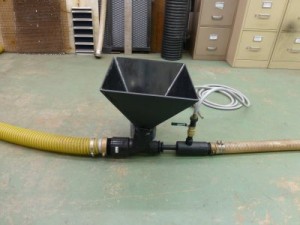
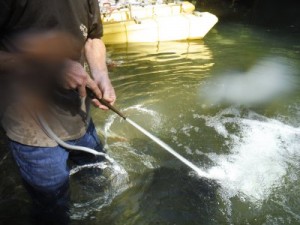
To my knowledge, you cannot buy these blow mining hoppers as ready-made devices. But they are not hard to fabricate at home. We glued our prototypes together with ABS plastic materials. We reduced the jetting down to ¾-inch tubing from the traditional 1 ½-inch pressure hose that extends from a 6.5 HP motor and pump. As you can see from the images, we added in a garden hose and valve so we can blow material into the hopper. You can also feed material into the hopper by hand. Through testing, we found that a 6.5 HP Honda will supply enough power to deliver material to either a 3-inch or 4-inch recovery system (sluice box) that can float on pontoons out on the waterway.
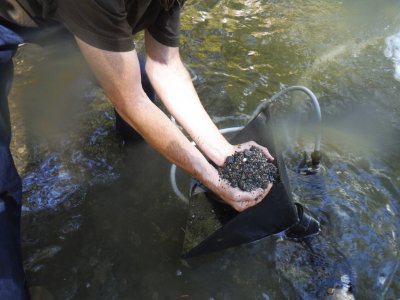
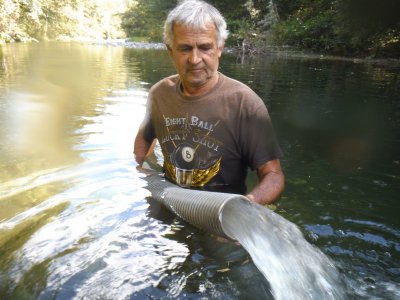
Several of our members began using these blow mining techniques late last season when the wardens started coming around to inform miners that the definition of suction dredging had been expanded to include any type of suction or vacuum mining on the bottom of the waterway. When the wardens were informed that these prospectors were only using blowing techniques to move stream-bottom materials, the wardens went away and that was the end of it.
We will leave one of the prototypes at the office so everyone can get a look at it. When constructing your own, I caution you to be mindful that no suction or vacuum can be used to excavate material off the bottom of the waterway. This is largely a matter of placing the pressure jet so that it blows material through a delivery hose. It is also a matter of creating a feed hopper which is large enough that it will catch materials directed its way without creating even a fraction of suction strong enough to perform excavation on its own. Some of our members are calling this an “underwater high-banker,” though I point out that the very same system is also effective above the water.
Here are some very helpful video sequences to demonstrate the system:
Legal Prize Winners!
This drawing was for three ounces in American Gold Eagle coins and ten ounces of Silver Eagles. The drawing took place just before closing time in our offices in Happy Camp on 28 February. Because she had no personal interest in the outcome, we asked Connie Rasmussen from the gift store next door to draw the tickets. In addition to our staff, there were a number of others present for the drawing.
1-ounce American Gold Eagle: Paul L Velotta
Quarter-ounce American Gold Eagles: Ray Crum, Larry Buzzell, Brian Cutler & Timothy J Gilbreth
One-tenth ounce American Gold Eagles: Lynn L Bourne, Les Martin, Philip F. Myska, Edward Murphy, Gary Standefer, Stephen Drinovsky, Chester Morris, Joe Sawyers, James A Karl & Fred Fifield.
One ounce American Silver Eagles: Jasper Bishop, Larry L Reiter, Alton Smithart, David Albrecht, Clark Morrison, Janis A Keene, Richard Stroda, Mike Keller, Phillip Sharpe & Joseph Schaberger.
I want to give a heart-felt thank you to everyone who participated in this fund-raiser. We can count this fund-raiser as another big winner for small-scale miners.
Congratulations to all the winners!
Any contributions received after the time of the drawing will automatically generate tickets for the next prize drawing which will be sponsored by The New 49’er Legal Fund. It will be for 15 more American Gold Eagles (3 ounces of gold) and 10 more American Silver Eagles (10 ounces of silver). The next drawing will take place at the New 49’er Saturday evening potluck in Happy Camp on 5 July 2014. You do not need to be present to win. You do not need to be a member of The New 49’ers to participate. Our office will automatically generate a ticket in your name for every $10 legal contribution we receive ($100 would generate 10 tickets). There is no limit to the size or frequency of your contributions, or to the number of prizes you can win.
Legal contributions can be arranged by calling (530) 493-2012, by mailing to The New 49′ers Legal Fund, P.O. Box 47, Happy Camp, CA 96039, or you can do it online by clicking here:
What We Can Do on Our Properties in California
Members have been calling in wanting to know what we can and cannot do these days for prospecting activity on our extensive property holdings in Siskiyou County. While I do not have a license to provide legal advice, I will follow with my own understanding of the current state of affairs.
1) We all know that suction dredging in the active waterways is closed until we overcome the existing moratorium in California. This is presently being challenged in two separate legal proceedings. Let’s just keep our fingers crossed on this turning out in our favor.
2) Surface mining (high-banking) is still alright. You can do that on your own, or you can join in on our Weekend Group Mining Projects. They are scheduled in 2014 as follows: May 31 & June 1; June 21 & 22; July 12 & 13; August 2 & 3; August 23 & 24. These events are free to all active Members, and everyone is encouraged to attend. Please contact our office in advance to let us know you will be there: (530) 493-2012.
3) Since our last newsletter, the State of California has submitted an application to the Office of Administrative Law to adopt its Emergency Regulations as permanent. This will do away with using any type of vacuum or suction to excavate material off the bottom of a waterway. Therefore, the underwater suction gravel transfer systems we used last season will no longer be allowed until we overcome the suction dredge moratorium.
4) There is no problem with booming (motorized suction mining) 100 yards from the active waterway. There is also a way to boom using blowing methods (see below) that should not be affected by the 100 yard rule.
Please note that all surface mining activities on New 49’er properties are governed by our internal set of Surface Mining Guidelines which are available from the office.
5) Underwater crevicing is what most active members were doing within the waterways at the end of last season, using the hookah and pump from their 5 and 6 HP motors on floating platforms to provide air for breathing and a jet of water to help move material out of the way. Most of this newsletter has focused upon this new method of moving material around by blowing, rather than sucking. Our attorney agrees this cannot be classed as “suction dredging” under the expanded definition.
The main briefs have been filed with the Third Appellate District of California in the Brandon Rinehart case. Brandon was cited a while back for operating a suction dredge in California without a permit. Brandon hired our attorney, James Buchal, to defend against the criminal citation. Brandon’s defense was largely based upon our federal preemption argument in San Bernardino Superior Court that the State does not have the authority to prohibit suction dredging, and that their refusal to issue a permit amounted to a prohibition. The judge in that case rejected the preemption argument on the presumption that we would appeal to the Appellate Court.
Now that the Appellate Court will consider federal preemption, we are on a fast track to get this very important issue decided. James Buchal did a fantastic job in presenting opening and closing arguments. We encourage you guys to read them, because they are very enlightening. The State’s argument is basically that congress never meant for the State to be prevented from stopping mining on the public lands. Anti-mining activists have also weighed in with their own arguments. So that you can more easily follow along in the progress, we have created a special page on the web site that includes all of the important briefs.
In the event that we win the federal preemption argument, our guess is that suction dredge permits will again immediately be available in California. This, because a judge will have ruled that prospectors can dredge even if California fails to issue permits. It is impossible to predict how long it will take the Court to issue a Decision. But it is possible it could happen before this next season. The New 49er Legal Fund is providing financial assistance to pursue the preemption argument in the Appellate Court, since that outcome is likely to resolve many of the unsettled matters in San Bernardino Superior Court.
The State of Oregon has passed a similar statewide moratorium (SB 838) on suction dredging (as California’s), except that it does not take full effect until 2016. The new law does affect the 2014 and 2015 seasons in several very important ways:
1) They are reducing the number of suction dredging permits to 850. This is approximately down to a third of the number of permits issued during the 2013 season. So the big question is who will get the permits?
2) The new law only allows the operation of a suction dredge between the hours of 9 am and 5 pm.
3) Suction dredges cannot be operated within 500 feet of each other.
4) No suction dredges may be left unattended on the waterway. This is generally being interpreted as a requirement to remove all dredging equipment from the waterway every evening.
At the time this newsletter is being published, Oregon State Lands is not yet processing permit applications.
Fortunately, we have our federal preemption arguments to (hopefully) overcome this nonsense in Oregon. To a large degree, the very same arguments we are using to try and overcome California’s moratorium will also apply to Oregon. How can a State promote mining on the public lands (which is a mandate from congress) when they require a miner to remove his mining equipment from his work site every evening? Or when a miner is prohibited from operating a motor at times when anyone else is allowed to do so?
Since we are already making the federal preemption arguments in California, we will likely wait to see how the Appellate Court decides before challenging the new law in Oregon.
Lost Treasure Hunters was Scheduled to Air!
Just as we went to print with the February newsletter, I received notice from the producer that Animal Planet had scheduled the full version of Lost Treasure Hunters (5 episodes) to play, starting at 8 AM on March 6th. Episode 1 can be found here. Then, a week or so before the show was to air; I was informed that the network changed its mind once again. No explanation has been provided, so the mystery continues. Perhaps it has to do with the ancient curse of the Golconda diamonds! Lost Treasure Hunters is a reality show that was filmed by Discovery Network about several friends and me who went on an extended expedition to India in search of one of the world’s richest diamond mines, a mine that has been lost for several hundred years. I am not allowed to tell you if we found the mine. But I can tell you that if you watch the show, you won’t be disappointed in what we found!
Sign up for the Free Internet Version of this Newsletter
We strongly encourage you to sign up for the free on line version of this newsletter. The Internet version is better. This is because you can immediately click directly to many of the subjects which we discuss; because the on line version is in full color; because we link you directly to locations through GPS and Google Earth technology; and because you can watch the free video segments which we incorporate into our stories.
Signing up also places you on our Political Action Team. Things happen so fast these days; it takes too long to organize political action through the U.S. mail. As an example, just two years ago, in concert with other mining organizations, our Internet Action Team killed anti-mining legislation in Oregon in less than a week. All of these future battles will be organized over the Internet since it is so much faster. Please join us in the battle to maintain our remaining freedoms!
Sign up for our Free Internet Newsletter!
The New 49’ers Prospecting Association, 27 Davis Road, Happy Camp, California 96039 (530) 493-2012 www.goldgold.com






